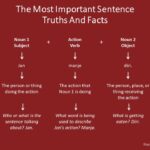The Most Important Sentence
Word order
Noun 1 + Action + Noun 2
Subject + Verb + Object
When to use this type of sentence?
General truths and facts
Simple present tense
Explanation
The most important sentence in Haitian Creole is used when speaking about general truths and facts. We also call this the simple present tense. Some examples in English are ‘John eats rice’, ‘Haiti is an island’, ‘she is a doctor’, and ‘cats eat meat’. All these sentences are general truths and facts. Many sentences in Haitian Creole are made up of a version of this sentence structure. Once you understand it, you will be able to create longer sentences.
The main topic or subject of a sentence is Noun 1 / Subject. A noun is a person, place, or thing. The Subject / noun 1 is the person or thing doing an action. Everything in the sentence is telling us what Noun 1 is doing. An example of this is
Jan + manje + diri.
John + eats + rice.
Who is the sentence talking about? Jan. Therefore Jan is Noun 1 / subject. The next part of a sentence tells us what action Noun 1 is doing. We call this the Action or Verb. For example,
Jan + manje + diri.
John + eats + rice.
What word is being used to describe Jan’s action? Manje. Therefore ‘manje’ is the action / verb. The last part of the sentence is Noun 2 or the object. Noun 2 / Object is the person, place or thing that receives the action of the verb. It is the who or what that Noun 1 does something to. In addition, it is the person, place or thing that is the result of the action. Let us look at the example above:
Jan + manje + diri.
John + eats + rice.
What is getting eaten? Rice. Therefore ‘rice’ is Noun 2 / Object. We have learned an important truth about Jan: Jan manje diri. Try making your own sentences describing truths and facts.
* Haitians also use Noun 1 + Action + Noun 2 to talk about things that already happened. Play close attention to the context.
Sample Sentences
Mak manje.
Marc eats.
Noun 1 = Mak
Action = jwe
*Do not always need Noun 2 / Object
Li se yon doktè.
She is a doctor.
Noun 1 = li
Action = se
Noun 2 = yon doktè
Ayiti se yon zile.
Haiti is an island.
Noun 1 = Ayiti
Action = se
Noun 2 = yon zile
Chat la manje vyann.
The cat eats meat.
Noun 1 = chat la
Action = manje
Noun 2 = vyann
Papa m rete Nouyòk.
My father lives in New York.
Noun 1 = Papa m
Action = rete
Noun 2 = Nouyòk
Ti chen an gen boul la.
The small dog has the ball.
Noun 1 = ti chen an
Action = gen
Noun 2 = boul la
Why is it important to start with Noun 1 / Subject?
This question is very important as you learn to talk about things that already happened or will happen. Do not forgot that most sentences start with Noun 1 + Action + Noun 2. Remember that Noun 1 / Subject is the person, place or thing doing the action. In English, we have sentences that do not always start with Noun 1.
Let us take this sentence: “I’m going to receive the text from my father“. In this sentence, who will actually do the action? Who will send the text? My father. The easiest way to say this in Creole is: “Papa m pral voye m yon teks.” My father is going to send me a text.
Let us take another example “I was bitten by a dog“. What did the action? What did the biting? The dog. The easiest way to say this in Creole is “chen an mode m” or “chen an te mode m.” The dog bit me.
Here’s one last example: Creole will be taught in school. Ask yourself: Who or what will actually do the action? Who or what will do the teaching? What’s the verb or the action? What will be the result of the action? What will be taught? Translating this sentence word-for-word in the exact order is not possible in Creole because the sentence would read that Creole will be doing the teaching. We have to use Subject + Verb + Object. The result is “Yo ap anseye Kreyòl lekòl.” They will teach Creole in school.
The easiest way to create sentences in Creole is by starting with Noun 1 / Subject.
